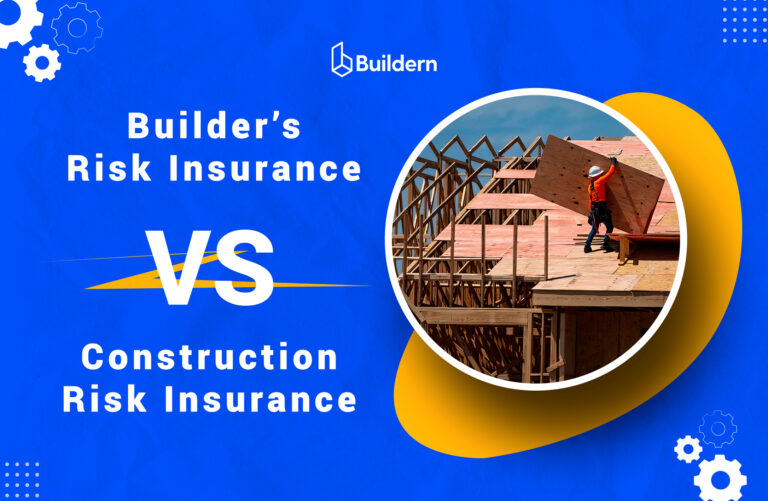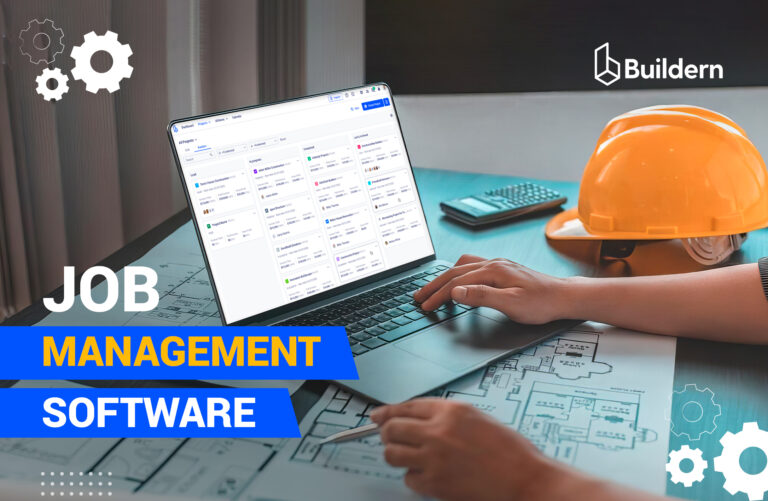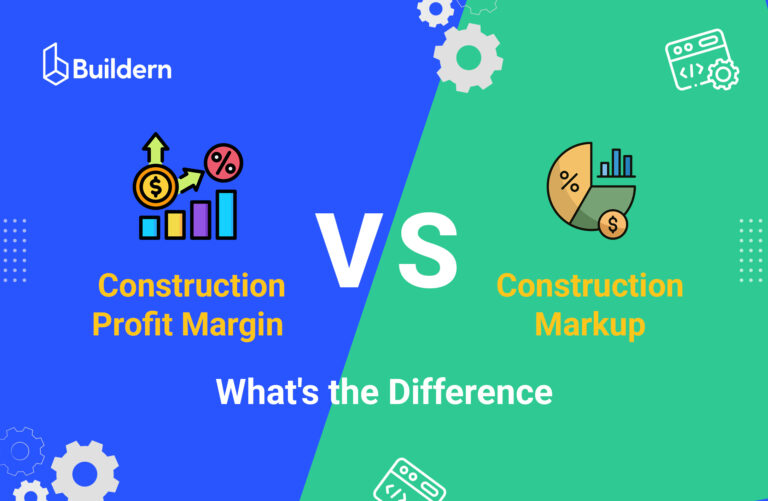6 Main Construction Billing Methods | Which Is Right for You?

Have you ever considered how the construction billing methods you choose impact the success of your project?
Selecting the appropriate billing method is not a decision to be taken lightly. It goes beyond mere preference; it’s about understanding the balance between ensuring timely payments and maintaining the financial health of the project.
With this in mind, we’ll help you make the right decision today by exploring the five main construction billing methods and highlighting their advantages and potential drawbacks. Additionally, we’ll discuss how our construction project management software can help streamline your billing processes, regardless of the method you choose.
Table of Contents
- What Is Construction Billing?
- 6 Most Common Construction Billing Methods Decoded
- So, Which Construction Billing Method Should You Choose?

What Is Construction Billing?
Construction billing serves as the financial backbone of the construction industry, acting as the starting point around which the flow of funds, project timelines, and client-builder relationships revolve.
The process involves systematically invoicing clients for the completed work, ensuring accurate and promp payments.
The effectiveness of construction billing methods is judged on three key factors:
- Speed and Promptness: How quick is payment processing, and how soon do clients pay invoices?
- Cost-effectiveness: How much does it cost to maintain the billing system?
- Accuracy and Transparency: Can clients easily track payments, expenses, and project progress?
6 Most Common Construction Billing Methods Decoded
The right billing approach can be the difference between a project that flourishes and one that struggles. With builders agreeing this is one of the most crucial aspects when signing onto a project, it becomes clear why the decision demands careful consideration.
Construction billing always refers back to the contract terms that dictate how builders will charge for their work. These terms are crucial as they provide a structured framework for billing, ensuring fairness and clarity for all parties involved.
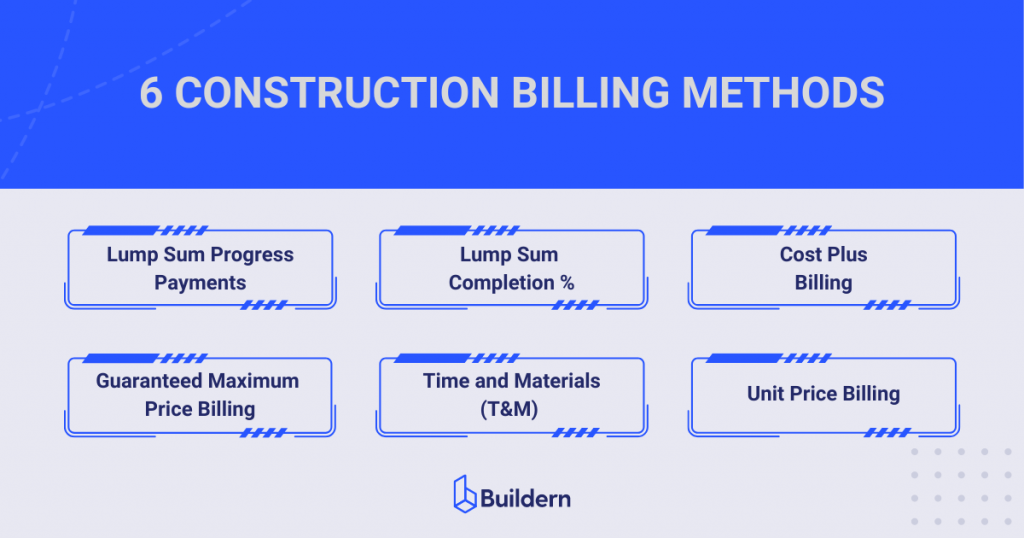
Let’s now dig into the essence of the most common methods of construction billing:
1. Lump Sum Progress Payments
Plain and simple, billing with a lump sum is when we agree on a fixed price for the whole job before the work begins. It’s like saying, “Here’s what I’ll do, and here’s what you’ll pay me for it.”
The builder can ask for the payment in advance or on project completion. However, depending on the project, it may be better to set clear payment schedules coinciding with project milestones or specific work stages.
This brings us to the two frequently used construction invoicing types used with lump sum billing:
- Progress payments
- Completion percentage (AIA-style)
In a nutshell, progress payments are partial payments made during different stages of a project, based on the schedules included in the project proposal. When the builder completes a pre-determined portion of the project, it’s time for them to receive payment.
Professionals in the construction industry recommend using lump sum progress payments when the project scope is clearly defined, and there is little expectation of changes or unforeseen conditions.
This can be especially useful for small to medium-sized projects. For example, residential home renovations mostly come with clear parameters. Both parties can agree to a fixed price outlining the costs and payment schedules from the beginning.
The Advantages of Lump Sum Progress Payments
- Predict and Control the Cash Flow: With lump sum progress payments, the builder can estimate and budget based on an agreed-upon forecast. They will know how much cash they’ll receive at specific points in time and what to expect throughout the project.
- Spot Payment Problems: In this type of billing, the client will have a clear understanding of the expectations and timelines. If there are discrepancies or delays in payment, the builder can use this as leverage. They can stop work until they receive the agreed-upon payment, giving them more control over project timelines and budgets.
The Disadvantages of Lump Sum Progress Payments
- Potential Disputes and Overbilling: Depending on the work’s complexity, lump sum progress payments can lead to disputes over work quality and overbilling. Contractors may inflate costs or submit invoices for incomplete work, while clients may dispute the quality of completed work and withhold payment.
- Limited Flexibility: With lump sum progress payments, there is less flexibility for changes or unexpected issues that may arise during the project. Any additional work or costs will need to be discussed and agreed upon, which can cause delays.
Lump Sum Progress Payments with Buildern
Now, let’s see what Buildern brings for builders working under lump sum progress payments.
When using Buildern through every preconstruction and project management phase, you can have everything correlated and accessible in one platform.
Here’s how Buildern users work with the progress billing method:
Here you can:
- Claim a percentage of the contract price. And by this, we mean that the builder can request a portion of the total amount when they reach specific milestones.
- Invoice based on your project change orders/variations. You can issue invoices based on the changes that have been made in the project or additional work that has been requested by the client.
- Invoice for allowance difference
- Invoice for custom lines
Buildern’s detailed invoicing and flexibility make it an essential tool for the effective management of your construction project’s finances.
2. Lump Sum Completion Percentage (AIA-Style)
Also known as AIA-style progress billing, this method differs from fixed price progress payments by invoicing upon completion of specific categories or per cost code within the project.
AIA-style lump sum invoicing depends on standardized forms introduced by The American Institute of Architects. This may include:
- AIA Document G702®–1992 (known as the AIA billing form or progress billing form)
- AIA Document G703®–1992
- Continuation Sheet
While working with AIA-style invoicing there are a couple of things to consider: AIA application and retainage.
What Is an AIA Application?
AIA form G702 is also titled “Application and Certificate for Payment” shorted to just application in most cases. The AIA application is a standard form that allows the builder to request payment for work completed on their project. Technically, it’s not an invoice but an application detailing the amount you’d like to invoice.
It outlines:
Project information in the header
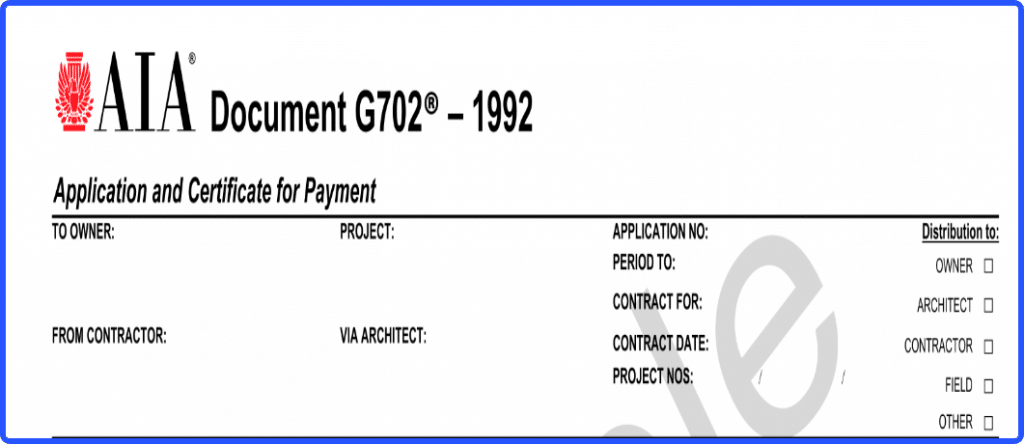
The application for payment with the actual charges (this includes multiple lines)
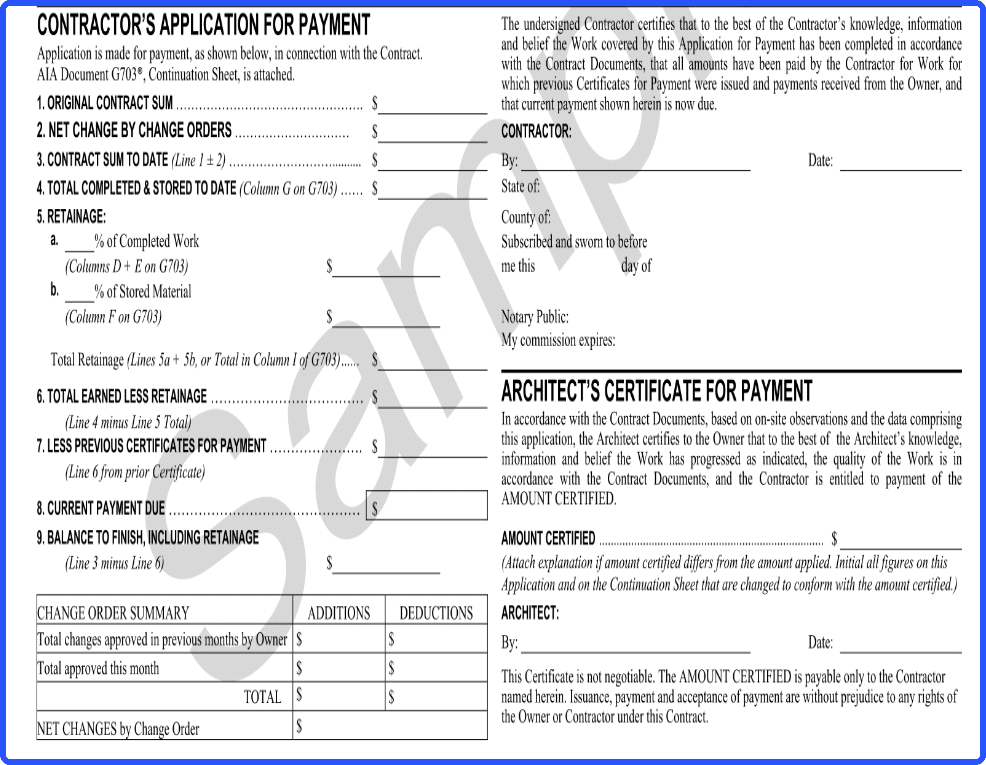
Signature and notarization
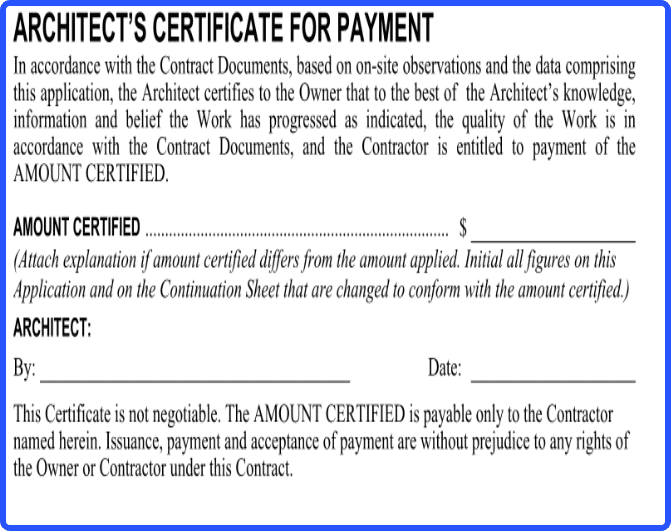
What Is Retainage?
Retainage in construction, sometimes called contract retention or holdback, is a portion of the contract price that the owner withholds from the general contractor’s payment. It is usually between 5-10%, but this percentage can vary depending on the project, country, or state.
💡Recommended Reading: Retainage in Construction: Security Measure for Owners, But What for Contractors?
The key idea behind retainage is the collocation “substantially complete”, meaning the retainage isn’t released when the project is finished but rather when it reaches a specific level of completion as defined in the contract. This ensures that the project is completed to a satisfactory standard before the final payment is made.
The Advantages of Lump Sum Completion Percentage Billing
- Builders can have more control over profitability with lump sum completion percentage billing. By knowing exactly what percentage of the total project cost is completed at any time, they can better forecast earnings and manage cash flow effectively.
- This billing method significantly reduces the amount of paperwork involved, as you will be working with premade standardized forms. This not only saves time but also reduces the chances of errors.
- Clients benefit from the transparency and predictability of lump sum completion percentage billing. They can rest assured that their project will stay within the agreed budget, making it an excellent option for those with strict financial limits.
The Disadvantages of Lump Sum Completion Percentage Billing
- The AIA billing forms aren’t free of charge. You will need to purchase a new form each time you issue a digital bill, as you are not allowed to reuse the billing forms. Plus, they require specialized expertise to produce accurately, increasing project costs.
- There could be disputes over the percentage of completion between the builder and client, leading to delays in payment and strained relationships.
(Lump Sum) AIA-Style Completion Percentage Billing with Buildern
The completion percentage billing supported by Buildern operates on a distinctive yet highly efficient premise.
Buildern automates the tracking of the remaining and already claimed value of a project’s work plan thus providing a realistic overview of the actual amount. The latter refers to the comparison between your budgeted cost versus the expenses incurred and payments made to date.
The contract price can be shown by cost codes or cost categories if you use Buildern for the AIA-style completion percentage billing.
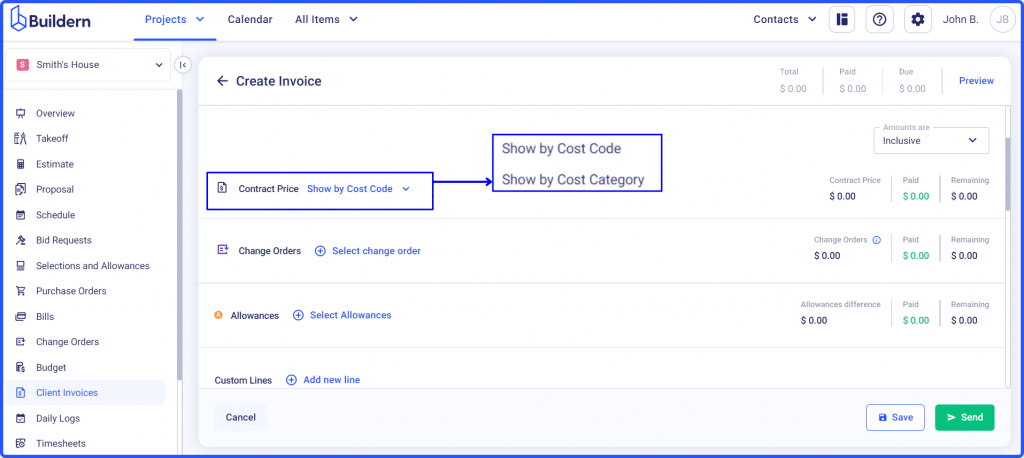
Essentially, it’s a way to measure the percentage of project completion based on your financial costs. For example, if you budgeted $1,500 for a specific project category and have already spent and paid $500 to sub/vendors for this category, Buildern calculates the ‘actual’ completion at 33.3%. This percentage is derived from the amount spent relative to the total budgeted cost.
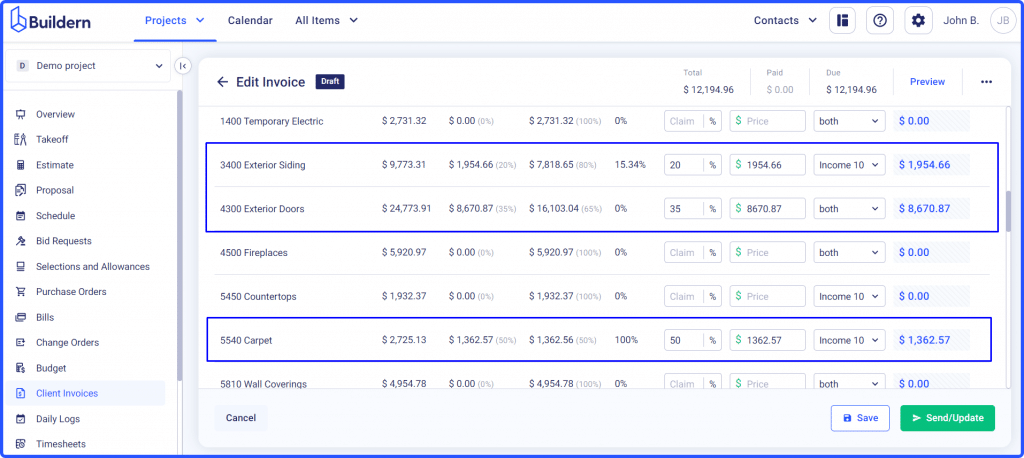
This feature gives you an immediate insight into each category’s progress and helps to make informed decisions for future project management and budget adjustments.
Here’s how Buildern helps builders issue detailed client invoices with the completion percentage:
This approach ensures that payments are directly connected to the actual progress of the work, providing an accurate billing method.

3. Cost Plus
Cost-plus billing, in a nutshell, is all about builders providing their clients with detailed reports of all project expenses as they arise. This could include everything from the cost of bricks to the wages of skilled workers. Then, based on the contract, you add a percentage of the total costs or a fixed fee as your profit.
Cost-plus billing can eliminate a certain level of risk for construction companies the final scope and cost of a project are difficult to determine upfront. The inherent flexibility of cost-plus billing allows for adjustments to be made with relative ease.
For example, if there are unexpected increases in materials and labor costs, contractors have the ability to pass these additional costs onto the client instead of absorbing them themselves. However, it is crucial to negotiate the terms of the contract thoroughly to ensure that such stipulations are clearly defined and agreed upon before commencing the project.
Some of the best practices for cost-plus billing imply that it is better to be combined with the Guaranteed Maximum Price. This will put a spending cap on the project and provide both the clients and builders with an extra layer of financial security.
The Advantages of Cost-Plus Billing
- It is easy to build trust with the cost-plus contract since the client knows precisely what they are paying for.
- The fixed builder fee makes room for lower risks in case of project delays or changes.
- Changes in the design can quickly be incorporated since items are billed at cost value.
The Disadvantages of Cost-Plus Billing
- You will need to be alert to ensure the document flow goes just as planned. As cost-plus contracts require constant invoicing for every expense, it can be a tedious task to track everything and ensure the markup is correct.
- Your reputation will hang on the final markup percentage, which needs to reflect your true value without making it too high for the client.
Cost-Plus Billing with Buildern
Managing your finances with Buildern means having complete control over the billing process with a clear overview of project progress and accurate invoicing.
Using cost-plus, your construction invoices created via Buildern can contain the following items:
- Bills
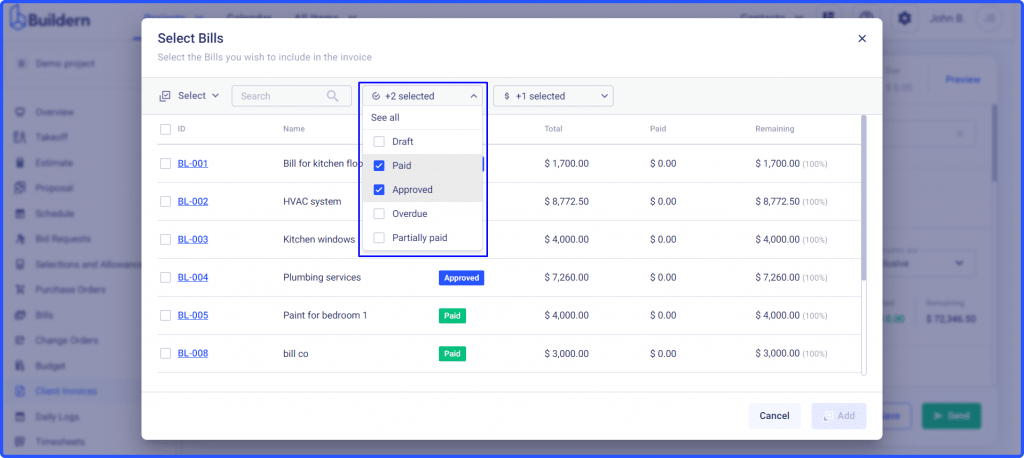
- Timesheets
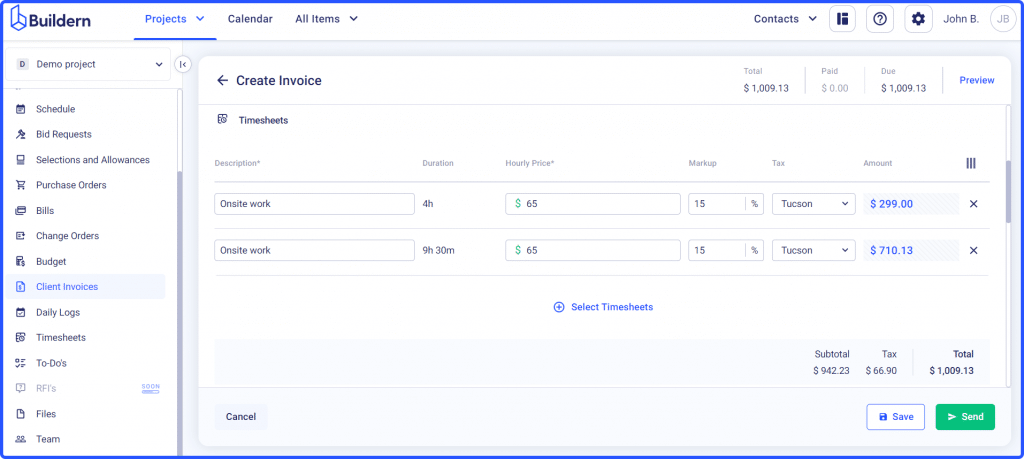
Imagine you’re building a home and every expense that goes into the construction process – from materials to labor – is paid for by your client, plus your markup percentage.
This can seem like tons of calculations and constant back-and-forth paperwork that will stress you and your client at the end. Indeed, it’s a system that requires detailed record-keeping and clear communication.
But it shouldn’t be as hard as it seems.
At least it is not for Buildern users, where all project expenses are automatically tracked and calculated.
Cost-plus is a valued method ensuring that clients are only paying for what is genuinely needed plus a reasonable markup for your expertise and management.

4. Guaranteed Maximum Price Billing
Alright, so next up, we have guaranteed maximum price billing. Now, if the phrase itself sounds a bit intimidating, don’t worry. It’s actually a pretty straightforward concept.
Builders working with GMP will set an upper limit for the cost of the whole construction project. Unlike other billing methods in construction, this one gives builders a clear budget to work within. Clients love it because it offers them financial security. They know their project won’t suddenly balloon in cost.
The Advantages of Guaranteed Maximum Price Billing
- Financial Security for Clients: As mentioned before, clients can rest easy knowing they won’t be hit with unexpected costs or budget overruns.
- Collaboration: GMP billing encourages open communication and collaboration between clients and builders. It also means that both parties have a shared goal of completing the project within the set budget.
The Disadvantages of Guaranteed Maximum Price Billing
- Limited Flexibility: Since there is a set budget, GMP billing may limit the flexibility of making changes or additions to the project.
- Inherent Risks for Builders: If the project comes under budget, the savings can be shared between the builder and the client, depending on the agreement. Moreover, the builder will not get paid for any additional costs exceeding the estimated price.

5. Time and Materials (T&M) Construction Billing Method
As the name suggests, builders working under time and materials contracts, charge their clients based on the actual time spent on the project and the materials used. This method can be helpful for projects with uncertain or fluid scopes, where it is difficult to estimate the total cost beforehand accurately.
Builders may often mix T&M billing with the previously discussed GMP by setting a “not-to-exceed” clause in their contract. This ensures the client will not be charged beyond a certain limit, even if the project takes longer or requires more materials than estimated.
The Advantages of Time and Materials Billing
- Flexibility: T&M billing allows for flexibility in terms of project scope changes and additions, as long as the client is willing to pay for the extra time and materials.
- Accurate Billing: With this method, clients only pay for the actual time spent on the project and materials used, making it a more accurate billing approach.
The Disadvantages of Time and Materials Billing
- Less Certainty: Unlike the fixed-price method, T&M billing does not provide clients a fixed price for their project. This can make construction budgeting and financial planning more challenging
- Rising Labor Prices: If the price of labor rises after the contract is signed but before the project is completed, builders might have to absorb the additional costs. This situation can lead to reduced profits or even losses on a project if the contract does not allow adjusting the rates based on increasing labor expenses.

6. Unit Price Billing
Last but not least among the most common construction billing methods is unit price billing. This method involves charging clients for each unit of work completed, such as per square foot or item. For example, a builder may charge $10 per square foot for laying tiles in a bathroom.
Unit pricing is suitable for projects with repetitive tasks or clearly defined units of work, such as road construction or roofing projects. It can also be combined with other billing methods, such as T&M billing for additional materials.
Alternatively, builders can bundle labor, material, equipment, markup, and other details into a single unit and charge by it. It all comes down to the builder-client agreement and the project’s scope and complexity.
The Advantages of Unit Price Billing
- Crystal Clear Financials: Unit pricing helps builders and clients to accurately track the costs of specific tasks, making it easier for both parties to understand how to use the money. This results in enhanced budget management.
The Disadvantages of Unit Price Billing
- Excessive Granularity: Builders working with unit pricing may go into too much detail when it comes to invoicing. This can make it challenging for the clients to know the total project price until the work is complete.
So, Which Construction Billing Method Should You Choose?
Too much information to process, isn’t it?
Coming up with the right methods for managing your construction financials can be overwhelming, especially under the pressure of upcoming deadlines and client meetings. Still, the success of your project may greatly depend on this very decision.
So, here are a few key takeaways from our article to guide you:
- Each construction billing method offers varying degrees of flexibility and financial clarity. Whether it’s the predictability of fixed-price contracts or the transparency of time-and-materials billing, choose the one that aligns with your corporate culture and clients’ expectations.
- The right billing approach aligns with your project goals, scope, and complexity. It’s about finding the balance between risk and reward.
- Proper billing practices pave the way for smoother project management, ensuring that both builders and clients are on the same winning page.
Whichever method you choose, manage your construction financials with Buildern!
This is the only software you’ll need to manage the whole project like a pro. Sign up for a free trial now (no credit card required) to take the guesswork out of your workflows and focus on what you do best – building and creating!

